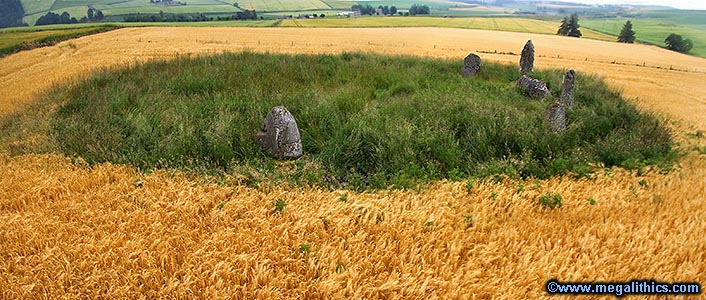
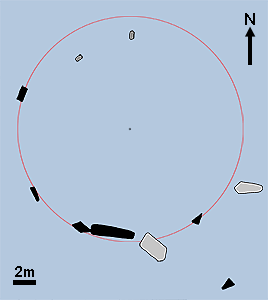
 |
 |
|
|
More Pics |
|
3D Vision |
|
Rock Art | ||||
|
|
Panorama |
|
Infrared |
|
Antiquarian |
Balquhain, also known as Chapel of Garioch or Inveramsay, is located about 3km SW of Inverurie on the SE slope of a hill overlooking the A96. The circle stands at an altitude of 100m in farmland, the field having been in arable use during all of our visits. Time has not been kind to Balquhain, only four circle stones and an outlier still stand, although luckily the western flanker is among those erect.
The present state of the circle is very similar to that described by Logan (1) in 1829, although he does mention that one of the stones had fallen recently, it being "lately overturned in consequence of some people digging too near it". Logan is probably referring to the fallen stone at the SE, which if still in place, may have provided an accurate diameter for the circle. With only a short arc of stones still in place the original diameter of the circle is uncertain, Fred Coles (2) measured the site in 1900 and estimated a diameter of 19.5m, producing the plan and engraving below, while Thom's (3) more recent measurements of the remaining stones in 1980 produced a best fit circle of 20.7m.
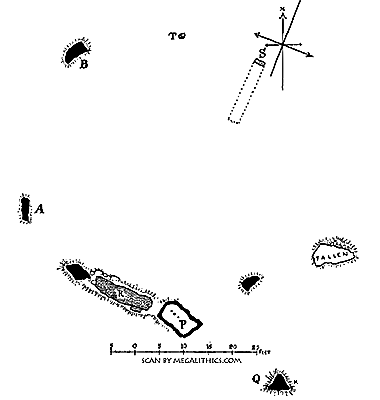 |
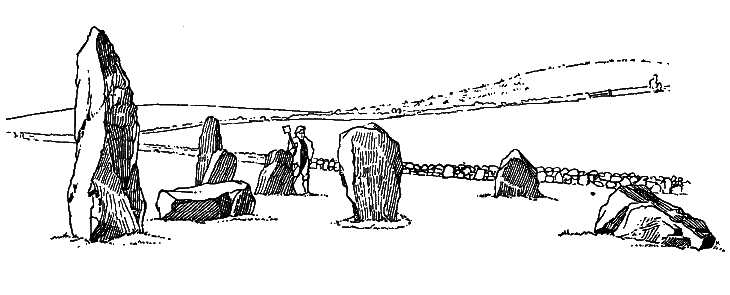 |
The recumbent stone is 3.8m long, 1.05m thick, and stands around 1.7m high in the middle, it is estimated to weigh over ten tons and is of a white grained granite that Burl (4) suspects "may have been brought from some distance". The outer face of the recumbent is very flat, looking almost dressed, while the inner face is very irregular, if this stone was selected for its flat face, then this was purposely set facing outwards. The recumbent has a large block set underneath it at the east and there are several smaller stones visible along the inner base, despite these foundations the recumbent has fallen a little and now stands tilted into the circle interior.
The flankers are very dissimilar, the fallen eastern stone is a 2m long flat slab of close-grained grey whinstone, while its 2.25m tall western counterpart is a sharply pointed piece of rough reddish quartzite bearing white quartz inclusions. One of the inclusions is quite striking, forming an elliptical "eye" set in the middle inner face of the stone. The heights of the remaining upright circle stones would suggest that the intact circle had been height graded up to the recumbent, a characteristic feature of Recumbent Stone Circles (RSC's) as is the placement of the recumbent stone in the SW quadrant of the circle. The original circle stone count is thought to be 12, this figure being derived from the spacing of the remaining stones, only a thorough excavation of the site and socket holes could confirm this.
The most spectacular stone at the site is not part if the circle itself, it is the outlier which stands 3.5m outside of the circle at the SSE, a massive 3.2m tall pointed pillar with a triangular cross section. As if sheer size was not enough, the pillar is composed of brilliant white quartz. To our knowledge, no other RSC has an outlier quite as unusual as this, it really is stunning, even Fred Coles (2) described it as "intrinsically remarkable" and "a novelty in this survey". We noticed that pure white faceted quartz was exposed to a great extent on only one face of the stone, and that this face had been set facing to the south, and the moon. RSCs are monuments inextricably linked to the moon, and in a dark environment the southern face of the outlier would reflect moonlight strongly, given its size and elevation it would be visible for a great distance, tree cover permitting. It is also interesting to consider the choice of white granite for the recumbent, which would have been obtained at quite some effort if Burl is correct about its non-local origin, its white crystalline composition and unusually flat outer face, set facing south, would make this the next most reflective stone in moonlight. Quite a light show!
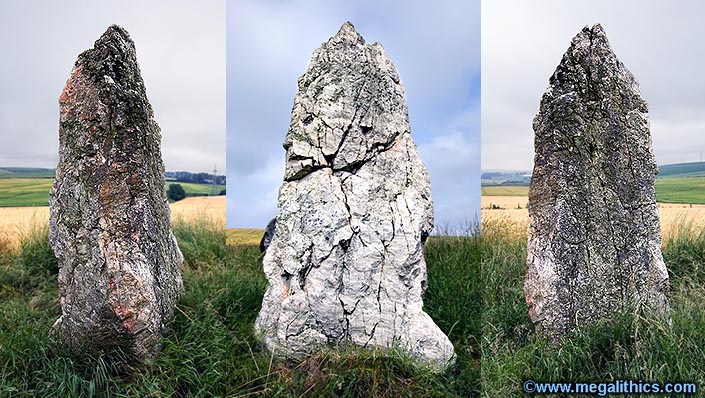
The three faces of the outlier, guess which one faces the
moon?
One thing did puzzle us, the stones at the site have substantial lichen growth over all of their surfaces, but the reflective southern "business end" of the outlier has very little. Given the absence of a millennia old maintenance program, how did the builders ensure the reflective face of the outlier would stay lichen-free and shiny for over four thousand years?
The stones at Balquhain bear rock art, some certainly original, some doubtful. The recumbent seems to have a single large cup on its upper inner edge, however there are suggestions that this may be a modern drill hole, and the fallen eastern flanker has four cups on what is now its upper surface. The circle stone at the SW has at least 24 cups on its outer surface, only the recumbents of Rothiemay (119 cups), and Sunhoney (31 cups) can better this count, making this stone the third most decorated of all RSCs. The positions of the stones bearing rock art, including the "modern" cup on the recumbent, all have lunar astronomical significance. The "modern" cup and the eastern flanker are aligned to the major moonset, the SE stone to the minor moonset (5). Spotting the rock art is difficult, the all-covering lichen not only creates a camouflage pattern over the cups, it also partially fills them in, try as we may we could not spot two of the cups on the SW stone that are very evident in Ritchie's (6) photo. Click on our rock art button above for photos of the cupmarks.
Recent work suggests that it is likely that all RSCs have ring cairns (7,8) as early phases of their construction, but there are no traces of a ring cairn at Balquhain. This is probably due to the long agricultural use of the field, indeed, Logan (1) describes the circle interior as "having been ploughed over" so that "no vallum or interior work is perceptible". Fred Coles probed the interior of the circle (then in pasture) for signs of a ring cairn and discovered a largish stone shown as "S" on his plan. Encouraged by his find, he returned the next day with friends and dug a trench, discovering a pavement of boulders, large rough stones, and another large earth-set stone ("T") about 15-20cm below the soil. We spotted two largish stones in the interior during our visit (see modern map, top), one (see photo below) was exposed and the other buried in vegetation. If these were the stones discovered by Fred they have been moved about a bit since his day.
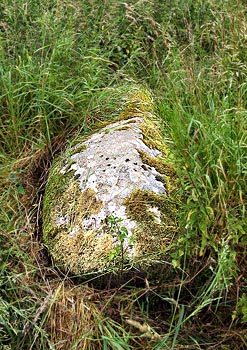
The uncertainty over the original diameter meant we could not estimate a centre accurately, so although we took panoramas and photos from a "guestimated" centre, due to the uncertainty we have not described them as centre shots. Similarly, the ranging pole visible near the recumbent is only approximately at true south.
Unfortunately the field was in crop during our later visits to Balquhain, although we were very grateful for permission to visit the circle in 2004 despite this, our movements were limited to the "wheelings" in the crop and we could not photograph the circle from some angles, sorry.
1.
Logan J., Archaeologia, 22, p.200-202, 1829.
2. Coles F.R.,
Proceedings of the Society of Antiquaries of Scotland, 35, p.230-7,
1900-1.
3. Thom A., Thom A.S.,
Megalithic Rings, B.A.R. 81, p.172-3,1980,
Oxford.
4.
Burl A. in Thom A., Thom A.S.,
Megalithic Rings, B.A.R. 81, p.173,1980,
Oxford.
5.
Burl A.
The Stone Circles of Britain, Ireland and Brittany,
p.227, Yale University Press, 2000,
Newhaven & London.
6.
Ritchie J.,
Proceedings of the Society of Antiquaries of Scotland, 52, p.98, 1917-18.
7. Bradley R., Discovery and Excavation in
Scotland, 1, p9 2000.
8. Bradley R., Antiquity, 74, p465-66,
2000.